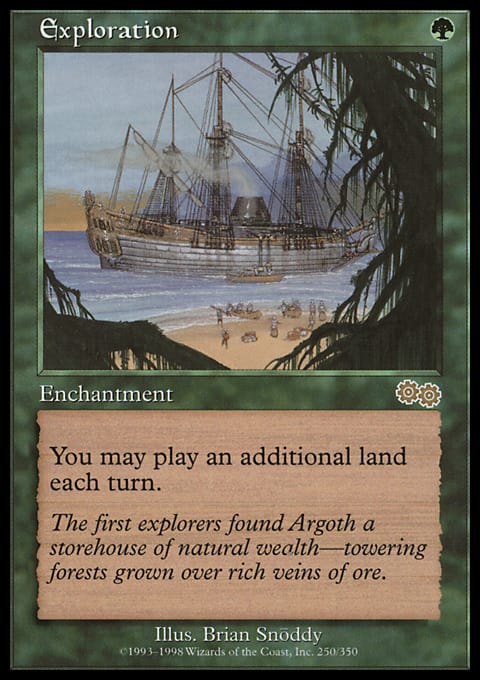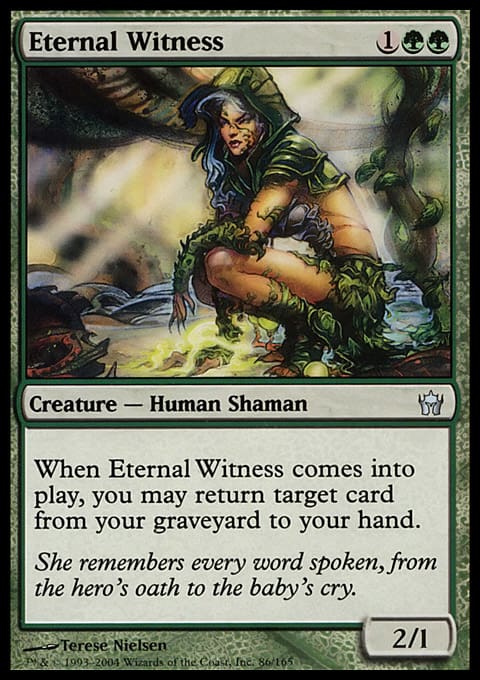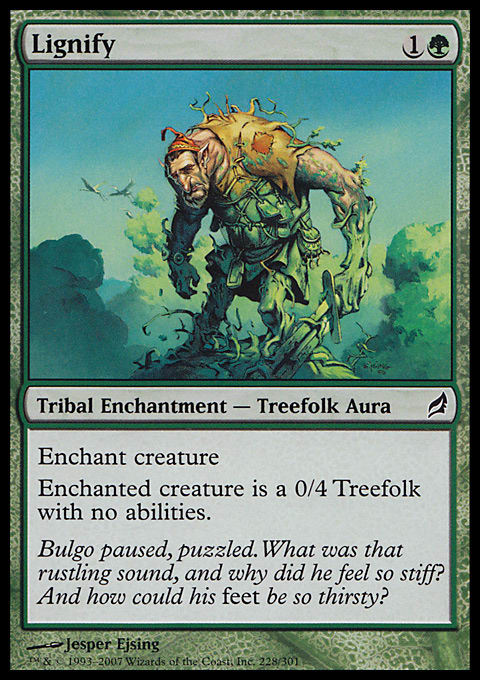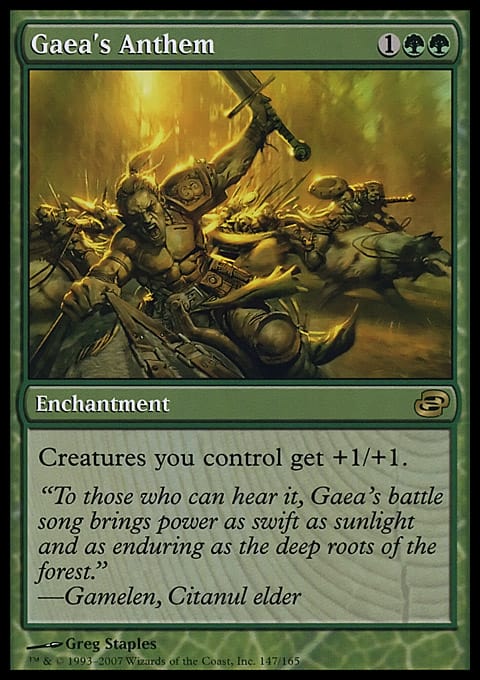If you want to win with that green deck at your next multiplayer night, keep on reading! Today, I want to discuss how you can win with green. Green has some advantages in multiplayer, but it also rocks some weaknesses. We’ll look at both and then consider what to do in order to win.
This is part five of a series designed to look at how to win with each of the colors when dialing it up against multiple foes. We have looked at blue, red, white, and black in that order, and we now finish with my personal favorite color for multiplayer. Despite green being my affectation, it is not the strongest color. They are, in order from worst to best:
- Red
- Blue
- Green
- Black
- White
Green is right in the middle. Green does not have the weaknesses of most of the other colors, but it also lacks a lot of strengths. Let’s look at what and who green is.
First of all, green has a massive love affair with lands. On any given effect, if it involves lands, green has it. Green can tutor for a land, green can put a land into play from almost anywhere, green can recur a land, and green can destroy a land. Green really has a thing for lands.
And I mean really. Land acceleration—and to a lesser degree acceleration via enchantments and creatures—is the thing green can really hang its hat on. Every other thing green does of value other colors can also do. Mana smoothing and acceleration is its raison d’être. From Llanowar Elves to Exploration, and from Cultivate to Budoka Gardener, this is green’s thing.
In fact, green loves lands so much that a lot of its creatures care about lands, too. Consider Terravore, which is a Lhurgoyf variant that inflates by the number of lands in graveyards. Take a look at Molimo, Maro-Sorcerer, who also grows bigger with your lands. Avenger of Zendikar is a real land lubber.
Almost as much as green loves lands, it really loves creatures. Green loves making creatures en masse with tokens as well as having a lot of effects tied to creatures. It can search for creatures, put them into play, and draw cards off them. Green loves creatures and lands.
Green is very strong at recursion—bringing cards back to its hand from its graveyard. It can restock any card with spells from Regrowth on down. Green loves the graveyard recursion, and some of its best cards of all time, such as Eternal Witness, are in this genre.
But green doesn’t do a lot more that matters. Green can destroy artifacts and enchantments in small amounts or sweepingly. Green can target lands for removal. It has a few tricks to finish a planeswalker (such as Rootgrapple).
Green has a few minor abilities. It can Fog, which has some value in multiplayer, but not a lot. It can also Giant Growth stuff, but many other colors have been seeing these effects printed recently. It likes to place +1/+1 counters on creatures, and that has some synergy in specific decks.
Trample is not a bad keyword, and it upgrades many boring creatures into interesting ones. Most of its other normal keywords abilities are fairly week, and let’s look more closely and reach and flying.
The biggest weakness of green revolves around two things that are tied together. One, it cannot fly in the sky to compete with any other color. This is a serious weakness. It has a ton of creatures with reach to block them, but it lacks the ability to swing in the air for itself; plus, many creatures that are aerial can just smash-hammer the Spiders that can web up the sky and block them. The number of Spiders that can successfully block and survive an attack by the Akroma, Angel of Wrath or a nasty Dragon is very small. It is even less likely that these Spiders will trade with the nasty flyer. Reach is a poor substitute for flying. Now, green can destroy flyers to make up for it. Ever since Hurricane, flying has been hated by green. You have mass removal for flying as well as many pinpoint removal options. But if an opposing creature is not flying, good luck doing anything from green other than massaging it. Green has virtually no options to shut down an opposing creature. Most of those options are Auras that are weak to enchantment removal, the creature being bounced or flicked, and so forth. Vow of Wildness, Utopia Vow, and Lignify are good examples.
The other major weakness of green is that when it does almost anything not discussed, it has many weakened ways of doing it. Sure, it’s not the worst at card-drawing in the world, clocking in at number three in raw card-drawing after black and blue. But it draws cards awkwardly (Hunter's Insight). Its combo pieces tend to be a bit more unwieldy. It reaches more for the other stuff.
Now that we have looked at what green does, how does this play out in multiplayer?
First of all, mana acceleration is very nice in multiplayer. Creature acceleration is destroyed by removal very quickly (as does artifact acceleration). You can rely on a Birds of Paradise to amp you early, and then once it dies, you have already used its mana in the early game to push your board position. But land acceleration is often with you for the whole game. Increasing your mana to the time when you are playing really big stuff can push any deck over the edge, which green is naturally built for.
Fogging is a weak ability because you can be attacked by each opponent every turn. Simply preventing damage once from one attack is hardly a way to keep yourself alive. Play foggers that can be used multiple times, such as Spike Weaver. Now, there are times when you may want a surprise Fog, but I like to play a Fog that can do other things, too. Some Fogs can be used on offense or in certain decks. We have Fogs that prevent damage from creatures that don’t have trample or don’t have +1/+1 counters on them. Consider a Fog that can keep creatures tapped (Spore Cloud or Tangle) or is a creature such as Spore Frog.
Life-gain is okay in multiplayer. The problem is that white has most of the good multiplayer life gain—such as Congregate and Invincible Hymn. Gaining a simple 4 or 8 life with one spell often doesn’t have a major impact on the board and just wastes a card. Instead, run things that will gain you life while doing other stuff. I’m thinking of cards such as Essence Warden, Wellwisher, Engulfing Slagwurm, and Thragtusk.
Giant Growthing is weak in multiplayer as well. If you are going to run it at all, I suggest a card such as Vines of Vastwood since it can help in other ways. Otherwise, I’d recommend sticking to pumping permanently with counters—such as with Forgotten Ancient—pumping the whole team—with Overrun effects—playing the occasionally powerful Aura—such as Rancor—and pumping permanently—with enchantments such as Gaea's Anthem.
Destroying your opponents’ stuff always leaves a nice feeling. The problem is that while you do have some sweeping enchantment or artifact removal, you don’t have a lot. If you want to sweep them, make sure you find things like Tranquil Grove and Creeping Corrosion.
The lack of flying creatures is a weakness that cannot be overstated. Flying creatures are like a nuclear bomb. The more people play them, the more people need them to keep themselves safe. So they see increasing use. Flying creatures are vital and a very important part of any multiplayer metagame. But you are the only color sans real flyers. Guys like Jugan, the Rising Star and Cockatrice aren’t going to get it done. The Spider crew also doesn’t have it. Even with ways to blast flyers in your removal suite, there are a lot of holes. You have some flyers that won’t die to targeted removal (Simic Sky Swallower is one example). Some flyers will resist the damage-based sweeping removal that green rocks because they have large butts or don’t take the damage (such as Avacyn, Dawn Elemental, and Iridescent Angel). People lean into these sorts of flyers in multiplayer naturally.
You are the only color that has to worry against a blue deck packing counter spells. If you have a lot of your deck dedicated to mana acceleration, the number of business cards is greatly reduced. A bad blue deck that runs too many counters can own you. Black can make you discard, but a top-decked nasty card built off your acceleration will break the black player’s back. Similarly, white can mass-remove your board position, but your lands help you out. Red can try to blast those lands but can’t fight it enough. Blue’s counters are your biggest enemy.
So, what are the strategies to winning as a player of green?
Strategy #1: Play Land Acceleration – Creature-based acceleration can be fragile, but when you Rampant Growth out one land, that land is there for the game, barring a mass-land-removal spell. When any other color grabs a creature with a spell (such as with Zombify) or brings an artifact (Fabricate) or enchantment (Idyllic Tutor) to the player’s hand, those cards will eventually be destroyed. But lands that accelerate one’s mana are rarely targeted for removal. You can play Kodama's Reach safely. It is unlikely to be countered, and the lands are likely to be out there for the whole game—which is guaranteed card advantage.
Strategy #2: Enhance Your Beef – As a general rule, green’s ground-pounders (gropos) tend to outclass gropos that others have. So, make sure that you play threats on the ground. If your beefy ground threat manages to keep back the opponent’s flying threat so the player can potentially block—or so he won’t provoke your attack—it did a lot of good. I prefer beaters that also do other things, such as those with enter-the-battlefield abilities like Woodfall Primus and Sylvan Primordial.
Strategy #3: Play Around Mass Removal – Your creatures tend to be especially weak to mass removal. You don’t have a lot of large regenerators or indestructible dudes, and the damage-based removal of red, such as Magmaquake, owns your ground creatures. There are some strategies you can use to increase your ability to survive a mass-removal spell. The first is to run some token-makers that make armies on their own. If you play Grizzly Fate and make four 2/2 dorks with one spell, you can either recover from a mass-removal spell very quickly (because you didn’t expose the better creatures) or you can drop it post-removal to make an instant army. Green cards such as Crush of Wurms are great at this. Another way to play around it is to rock recursion. Sure, that awesome Multani, Maro-Sorcerer may have bit it, but you can bring it back with a Recollect or something and recur your best dead beater right back onto the battlefield. But the third and best way to fight mass removal is to include creatures that leave something when they die. Worldspine Wurm and Penumbra Wurm will leave friends when they die. Even things like Thragtusk, Symbiotic Wurm, and persist creatures have value here as well. With these three tricks in your deck, you can establish power and fight through mass removal and still net that victory.
Strategy #4: Kill Flyers – When I look at green multiplayer decks, I often notice a serious lack of things like flying removal. Not every deck calls for the same cards, but many decks exclude it. Why ignore your only major way of facing one of your biggest weaknesses? I like cards that give you something else, such as Eaten by Spiders and Crushing Vines. Crushing Vines is great—if you do play against a deck without many flyers, it can still Shatter stuff for just 1 more mana than normally. It’ll work. I’d also run some mass removal to blast the sky when you can’t break the protection on a Sphinx of Jwar Isle or through those Lightning Greaves on a Butcher of Malakir. Whirlwind is your new best friend.
Green can win at the multiplayer table. By relying on acceleration and beef and making sure to pack enough removal for everything from enchantments and artifacts to planeswalkers and lands, green can win. If you have prepared for your metagame to face flyers and mass removal and you understand the dangers you face against some enemies (red’s ground-based removal, blue’s counters, and so on) you are in a good position to win the game and take home a little glory for all of those green decks out there.
Let’s hear it for green!
See you next week,
Abe Sargent

























